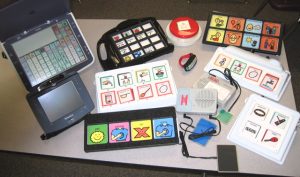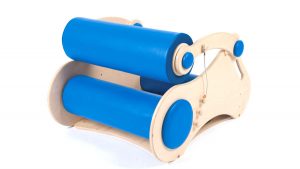Offset hallways are often located near the nurse’s office. They may hold social workers, speech therapists, counselors, paraprofessionals and other support staff. Special little rooms with calming hammocks, trampolines and stress toys are sometimes sandwiched between classrooms. These hallways may be in the middle of a school, but are more often set off to a side, out of the busiest hallway flow. These are hallways where America’s most challenged children may spend part or even most of their days.
In the offset hallways, children who cannot speak press buttons on assistive devices. More often, aides push buttons for them or guide their hands to buttons that answer questions.
In the offset hallways, children with few or no words squirm through devices designed to put pressure on them from above and below. Squeezing comforts and calms them.
Children may sit in their own teacher-designed cubicles. These children work best alone. Perhaps other children disturb them or even make them wordlessly angry. Perhaps they are known to be runners, ready to escape even if they don’t know where they are going or why.
Some children practice adding the number “one” to another number, over and over and over. Mostly they get it right and eventually they will be able to add ‘one” to another number automatically. They will know that
1 + 13 = 14.
The severely autistic may squirm on the ground, licking the floor, while someone tries to figure out how to get them off that floor without provoking a dangerous tantrum. When a middle-school or high-school boy the size of a football player decides not to cooperate with his special education program, all sorts of strategies may be tried, but in the end, it can be impossible to get that boy off the floor, at least in the short-term. Verbal persuasion only works when a student can understand the words being spoken, and safety comes first. The safest move may be to leave “Jay” on the floor until he decides to get up to take the coloring book or fidget toy being held out to him.
The verbal have learned various coping strategies and kids say to me throughout the day, “I am taking deep breaths.” I smile and say, “I take deep breaths myself.” They smile. They shake a little less.
I know this is not a safe space. The odds of being hurt on any given day are very low, but the social norms that prevent kids from erupting in rage or disappointment also don’t work well here. A scream sometimes cuts through lessons in these offset rooms. Screams come with the territory, especially when a child is frustrated or in pain. When a student has few or no words, that scream may be the best and most effective communication possible. Slaps, punches and bites are possible too.
“She’s a biter,” I was recently warned when I subbed in one of these hallways.
Fortunately or unfortunately, I am small, and probably about as scary as the Easter bunny. In the offset rooms, mostly my size and smile serve me well. I don’t kick off defensive or frightened reactions in many kids, no matter how confusing the world may seem to them. I look safe.
I enjoyed my last day subbing in one of these hallways. My favorite part was art class with a boy with Down Syndrome. We colored a top-notch frog and created an abstract of randomly traced stencil animals, one on top of the other with various pieces missing. We laughed a lot and we played dueling pencils a little. The boy did not seem able to talk much, but he was an expert snorter. He pointed at pretty parts of the school as we walked to and from class. At one point he did a secret handshake with me. Someone somewhere had taught him a complicated series of moves. When I left to go help the next kid listed on my schedule, he gave me a big smile and did say bye, maybe the third or fourth word of the last hour.
I liked music class too. I can sing “Are you sleeping, Brother John?” and “Row, row, row your boat” with the best of them. I talked for a while with a nice kid whose vocabulary mostly seem to consistently of the words free time and Kanye. He loved music. He made his own when none could be heard around him.
At one point, I talked with an aide about a girl in the class. She cautioned me to be careful about bonding too quickly with the girl. Teachers were working to help her learn about safe adults. I understood immediately. She’s a pretty girl, and she speaks well enough to hold a conversation. In a way, there’s not much scarier than a very slow, pretty girl who is nice to absolutely everybody. The world’s filled with treacherous twists and turns, including the tiny percentage of crazies who might take advantage of this girl.
Eduhonesty: I am impressed with the offset hallways, their teachers and aides. We try to mainstream students as often as we can, but we still need “life skills” classes. We still need to teach some middle school children to brush their teeth and put on deodorant. We still need to teach them how to make a sandwich and how to clean up when the juice spills.
I think of ESSA with its requirement that all children be prepared for post-secondary education. Is that the best use of our time? For all children? That wordless boy squirming and licking the floor? He’s not going to college. That wordless middle-school girl who moans and bites? She is not going to college either. But if she can be taught enough life skills, she may be able to live independently in a group home someday. At the very least, her aging parents will have an easier time caring for her.
These people writing multi-hundred page laws need to come out of their richly-decorated offices and spend a few days in school hallways — all the school hallways.



